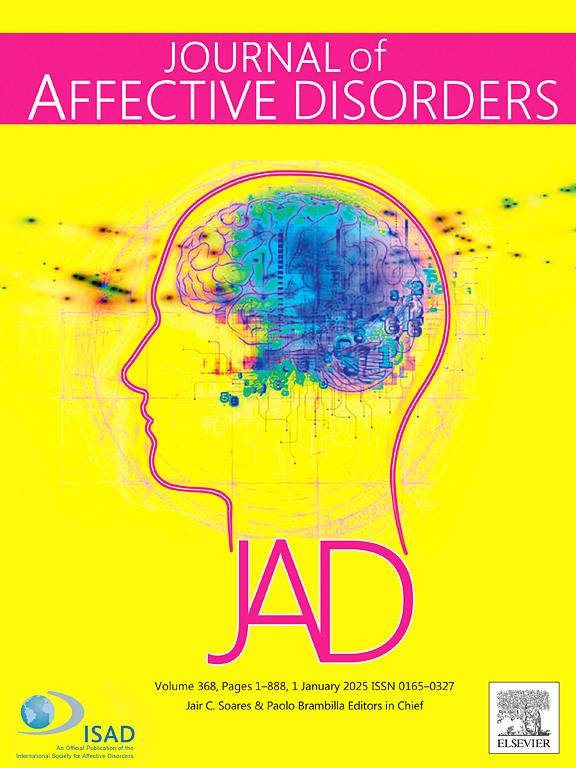年轻人得到他们需要的心理保健了吗?达到CAMHS年龄上限的年轻人临床样本的抑郁症状轨迹、相关因素和护理途径
IF 4.9
2区 医学
Q1 CLINICAL NEUROLOGY
引用次数: 0
摘要
确定抑郁症状持续到成年的年轻服务使用者,对于避免他们从儿童和青少年精神保健服务(CAMHS)过渡到成人精神保健服务(AMHS)时可能面临的潜在困难至关重要。由于抑郁症状的严重程度和稳定性各不相同,客观地确定哪些人需要持续的支持是很重要的。研究人员对来自8个欧洲国家的763名达到CAMHS年龄上限的年轻人进行了临床队列研究,以确定自我报告的抑郁问题(ASEBA青年自我报告和成人自我报告)在24个月的随访期间的轨迹,以及持续抑郁和服务使用的相关风险因素,使用生长混合模型。采用自我报告、父母报告和临床报告的访谈和问卷来收集持续性抑郁和服务使用的风险因素信息。我们确定了抑郁症状的低,减少,增加和高的轨迹。几乎所有持续性抑郁的风险因素都可以预测高轨迹(例如,更高的临床评定的精神病理学,更多的自杀倾向,合并症和成为欺凌的受害者),这些年轻人可能会过渡到AMHS或在晚些时候需要专业的精神卫生保健。更重要的是,根据风险因素,无法将抑郁症状增加到与持续高水平抑郁症状(增加轨迹)组相似水平的年轻人与其他年轻人适当区分开来,而他们需要继续治疗(在AMHS或CAMHS中)的可能性同样是护理的结束。本文章由计算机程序翻译,如有差异,请以英文原文为准。
Do young people get the mental healthcare they need? Trajectories of depressive symptoms, correlates and care pathways in a clinical sample of young people reaching the upper age limit of their CAMHS
Identifying young service users whose depressive symptoms persist into adulthood is crucial to avert potential difficulties they may face when transitioning from Child and Adolescent Mental Healthcare Services (CAMHS) to Adult Mental Healthcare Services (AMHS). As depressive symptoms are diverse in severity and stability, it is important to objectively identify those who require continued support. A clinical cohort of 763 young people from eight European countries, reaching the upper age limit of their CAMHS, was studied to identify trajectories of self-reported depressive problems (ASEBA Youth Self-Report and Adult Self-Report) over a 24-month follow-up period, as well as associated risk factors for persistent depression and service use, using growth mixture modeling. Self-reported, parent-reported, and clinician-reported interviews and questionnaires were used to collect information on risk factors for persistent depression and service use. We identified a low, a decreasing, an increasing and a high trajectory of depressive symptoms. The high trajectory could be predicted with almost all risk factors for persistent depression (i.g. higher clinician-rated psychopathology, more suicidality, comorbidity and being a victim of bullying) and these young people were likely to transition to AMHS or require specialist mental health care at a later date. More importantly, young people whose depressive symptoms increase to similar levels as the group with persistent high-levels of depressive symptoms (the increasing trajectory) could not be properly distinguished from other young people based on risk factors, while their needed continuation of treatment (either in AMHS or CAMHS) was equally likely as the end of care.
求助全文
通过发布文献求助,成功后即可免费获取论文全文。
去求助
来源期刊

Journal of affective disorders
医学-精神病学
CiteScore
10.90
自引率
6.10%
发文量
1319
审稿时长
9.3 weeks
期刊介绍:
The Journal of Affective Disorders publishes papers concerned with affective disorders in the widest sense: depression, mania, mood spectrum, emotions and personality, anxiety and stress. It is interdisciplinary and aims to bring together different approaches for a diverse readership. Top quality papers will be accepted dealing with any aspect of affective disorders, including neuroimaging, cognitive neurosciences, genetics, molecular biology, experimental and clinical neurosciences, pharmacology, neuroimmunoendocrinology, intervention and treatment trials.
 求助内容:
求助内容: 应助结果提醒方式:
应助结果提醒方式:


